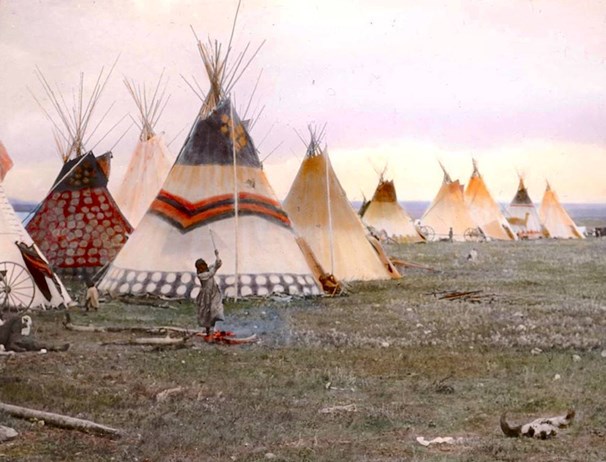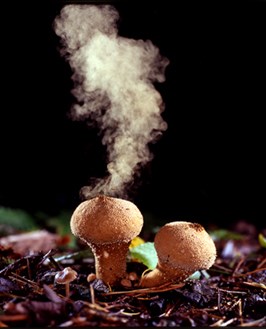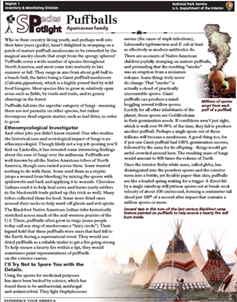Last updated: November 29, 2022
Article
Species Spotlight - Puffballs


Who in their country-living youth, and perhaps well into their later years (guilty), hasn’t delighted in stomping on a patch of mature puffball mushrooms to be rewarded by the magical smoky clouds that erupt from the spongy spheres? Puffballs cover a wide number of species throughout North America, and most come into maturity in late summer or fall. They range in size from about golf-ball to a beach-ball, the latter being a Giant puffball mushroom (Calvatia gigantean), which is a highly-prized find by wild food foragers. Most species like to grow in relatively open areas such as fields, by roads and trails, and in grassy clearings in the forest.
Puffballs fall into the saprobic category of fungi - meaning there are not parasitic on other species, but rather decompose dead organic matter, such as leaf-litter, in order to grow.
Ethnomycological Investigator
And other jobs you didn’t know existed. One who studies the historical uses and sociological impact of fungi is an ethnomycologist. Though likely not a top job-posting you’ll find on LinkedIn, it has revealed some interesting findings about the uses of fungi over the millennia. Puffballs are well-known by all the Native American tribes of North America, though uses varied across them. Some wanted nothing to do with them. Some used them as a styptic (stops a wound from bleeding) by mixing the spores with spiderwebs and bark and applying it to wounds. Cherokee Indians used it to help heal sores and burns (early settlers in the blacksmith trade picked up this trick as well). Many tribes collected them for food. Some wore dried ones around their necks to help ward-off ghosts and evil spirits.
The Blackfoot Native American Indian tribe historically stretched across much of the mid-western prairies of the U.S. There, puffballs often grow in rings (some people today call any ring of mushrooms a “fairy circle”). Their legend held that these puffballs were stars that had fell to the Earth during a supernatural event. They would use dried puffballs as a reliable tinder to get a fire going strong. To help ensure a hearty fire within a tipi, they would sometimes paint representations of puffballs on the exterior canvas.

I’ll Try Not to Spore You with the Details.
Using the spores for medicinal purposes has since been backed by science, which has found them to be antibacterial, antifungal and antimicrobial. They fight Staphylococcus aureus (the cause of staph infections), Salmonella typhimurium and E. coli at least as effectively as modern antibiotics do.
There are accounts of Native American children joyfully stomping on mature puffballs, and pretending that the resulting “smoke” was an eruption from a miniature volcano. Some things truly never do change. That “smoke” is actually a cloud of practically uncountable spores. Giant puffballs can produce a mind-boggling several trillion spores. Luckily for all other inhabitants of the planet, those spores are Goldilocksian in their germination needs. If conditions aren’t just right, which is well over 99.99% of the time, they fail to produce another puffball. Perhaps a single spore out of those trillions will become a mushroom. A good thing too, for if just one Giant puffball had 100% germination success, followed by the same for its offspring - things would get awful crowded around here. The resulting mass of fungi would amount to 800 times the volume of Earth.
Once the interior fleshy white mass, called gleba, has disintegrated into the powdery spores and the exterior turns into a brittle, yet flexible paper-thin skin, puffballs are like a loaded spring waiting for a trigger. A direct hit by a single raindrop will jettison spores out at break-neck velocity of about 100 cm/second, forming a centimeter tall cloud just 100th of a second after impact that contains a million spores or more.

A Wolf..., What Now?
Sometimes, one can’t help but wonder about the folks who come up with the scientific names for life. Case in point, about 50 puffball species hail from the Lycoperdon genus of life. Translated from the Greek, “Lyco” means wolf, and “perdon” means “to break wind.” Yup. It’s the wolf fart mushroom. The derivation of the ‘breaking wind’ part of the name is obvious, but why that offense is laid on a wolf is beyond the scope of mysteries this article can solve. “Lyco” is somewhat unexpectedly found in the scientific names of many common plants, including tomatoes and club moss, so there may in fact be little logic to it.
They’re a Sure Thing. Mostly.
Discovered early on, before they turn brownish and belch out their spores, puffballs are edible. If you slice into the flesh and it’s still pure white, you are good to add them to stir-fries or other recipes. Depending on the puffball species, flavors have been described as relatively flavorless (kind of like tofu, they absorb the flavor around them) to having a nutty, earthy flavor. Though you should never, ever (really - don’t do it!) eat a mushroom you aren’t 1000% sure about, puffballs are placed by wild food harvesters among the vaunted “Foolproof Four”of edible fungi, as they are easy to identify (for the record, the other three are morels, chicken of the woods, and chanterelles). There are exceptions however. Some particularly dangerous fungi can look somewhat similar to a puffball in the early growth-form known as the “button”or “egg” stage. Since they lack a flashing neon sign above them saying “Eat This and You Will Die”, mycologists have instead bestowed poisonous Amanita mushrooms with some of the most ominous sounding common names of any form of life. Hopefully no one would ID a death cap, death angel, destroying angel, or angel of death in a mushroom book and think: “Hey, that sounds delicious!” When edible, sliced-open puffballs should contain only pure white flesh, often likened in appearance to marshmallow or fresh mozzarella. The button or egg-stage of poisonous gilled mushrooms mimic puffballs until vertically sliced into revealing the future stem and cap of the Amanita in cross-section.
Doesn’t Pass the Sniff Test.
Puffballs have never been responsible for a human death as far as can be determined. Though on rare occasion, overzealous dogs inhaling copious amounts of spores have died. Humans that have purposefully done the same almost suffered the same fate. In a logic that only teenagers are capable of, eight Wisconsin teens in 1967 thought they could get a kind-of magic mushroom high from snorting puffball spores. Spoiler alert - they didn’t. What they did get was a month in the hospital when the billions of spores in their lungs found the moist conditions ideal to germinate. A series of fungicidal treatments were able to save all their lives. This is an actual named respiratory condition called Lycoperdonosis, which yes, translates to wolf fart disease. It may also have something to do with another name of the common puffball: the devil’s snuff-box. Oh the stories they must tell their grandchildren: “Kids these days! When we were your age we snorting from the devil’s snuff-box and fighting wolf-fart disease!”
For more information
- Learn more about how to properly identify edible puffball species.
- Watch this amazing time lapse video of puffballs growing and maturing.

Tags
- acadia national park
- appalachian national scenic trail
- eleanor roosevelt national historic site
- home of franklin d roosevelt national historic site
- marsh - billings - rockefeller national historical park
- minute man national historical park
- morristown national historical park
- saint-gaudens national historical park
- saratoga national historical park
- saugus iron works national historic site
- vanderbilt mansion national historic site
- weir farm national historical park
- species spotlight
- netn
- inventory and monitoring division
- native plants
- fungi
- puffball
- mushrooms
- spore
- science
